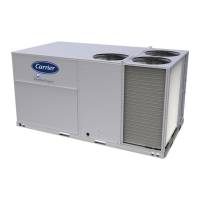41
2-1/64 (55)
51/64 (21)
4-1/4 (108)
2-3/4 (70)
NOTE: Dimensions in ( ) are in mm
C12036
Fig. 51 -- Enthalpy Control Sensor, Dimensions and
DIP Switch Location
Table 12 – Enthalpy Control Sensor
Wiring Terminations
a
Termi nal
Type Description
Nbr Label
1 S --- B U S S --- B U S
S --- B u s C o m m u n i c a t i o n s
(Enthalpy C ontrol Sensor Bus)
2 S --- B U S S --- B U S
S --- B u s C o m m u n i c a t i o n s
(Enthalpy C ontrol Sensor Bus)
a Terminals are polarity insensitive.
Table 13 – Enthalpy Control Sensor DIP Switch Settings
Use
DIP Switch Positions for Switches 1, 2, & 3
1 2 3
DA
a
OFF ON OFF
RA
b
ON OFF OFF
OA
c
OFF OFF OFF
aDA=DischargeAir
bRA=ReturnAir
c OA = Outside Air
When a S--bus sensor is connected to an existing network,
it will take 60 minutes for the network to recognize and
auto--configure itself to use the new sensor. During the 60
minute setup period, no alarms for sensor failures (except
SAT) will be issued and no economizing function will be
available.
Operating Sequences
Staged Air Volume (3--Speed) Fan Motor —
The Integrated Staging Control (ISC) Boardin themain
unit determines the operating speed
(LOW/MED/HIGH) of the indoor fan based on space
thermostat demand conditions. See Table 14 for this
logic.
Table 14 – Supply Fan Speed Logic without Economizer
TSTAT
OUTPUT
G/OCC 0 --- V 2 4 --- V 0 --- V 0 --- V
Y1 0 --- V 2 4 --- V 0 --- V 0 --- V
Y2 0 --- V 0 --- V 2 4 --- V 0 --- V
Y3 0 --- V 0 --- V 0 --- V 2 4 --- V
W1 0 --- V 0 --- V 0 --- V 2 4 --- V
W2 0 --- V 0 --- V 0 --- V 2 4 --- V
SUPPLY
FAN
MOTOR
SPEED
OFF LOW MED HIGH
W7220 Economizer Control —
Tables 15 and 16 provide the W7220 Input/Output Logic.
Table 15 describes economizer functions for a unit
without a CO
2
sensor. Table 16 describes economizer
functions for a unit with Demand Control Ventilation
(CO
2
sensor connected). The supply fan speed is included
in these tables for reference; this is neither an input or
output of the W7220 controller.
Base Unit Controls —
Base unit includes standard electromechanical controls,
Staged Air Volume (3--speed supply fan motor with VFD),
EconoMi$er X (with W7220 controller) and thermostat or
unitary controller that energizes the G terminal in cooling
and heating to control the supply fan operation.
Cooling, Unit With EconoMi$er X Without CO
2
—
For Occupied mode operation of EconoMi$er X, there
must be a 24--v signal at terminal G at the unit’s
Integrated Staging Control Board from the thermostat;
supply fan motor will start and run in Low Speed. The
signal at G is connected to W7220 input OCC, placing the
EconoMi$er X control in Occupied mode; the economizer
actuator is commanded open to the MIN POS L
ventilation position. Removing the signal at OCC places
the EconoMi$er X control in Unoccupied mode; the
economizer actuator is driven back to full--closed position.
When free cooling using outside air is not available, the
unit cooling sequence will be controlled directly by the
space thermostat. Thermostat call for Stage 1 Cooling
energizes ISC terminals G and Y1; supply fan motor starts
and runs in Low Speed. The Y1 demand is received at
W7220 terminal Y1--I. Outside air damper position will be
at MIN POS L. W7220 output Y1--O is energized; first
stage mechanical cooling starts.
As space temperature falls and space cooling load is
satisfied, the thermostat will remove its call for first stage
cooling; ISC terminal Y1 call is removed. The W7220
input Y1--I is removed; output Y1--O is de--energized,
stopping first stage cooling.
When ISC terminal Y1 is de--energized, terminal G may
remain energized, indicating Continuous Fan operation.
The supply fan motor will continue to run in Low Speed.
48HC48LC

